当前压载水处理技术介绍及比较_英文_
- 格式:pdf
- 大小:399.16 KB
- 文档页数:3
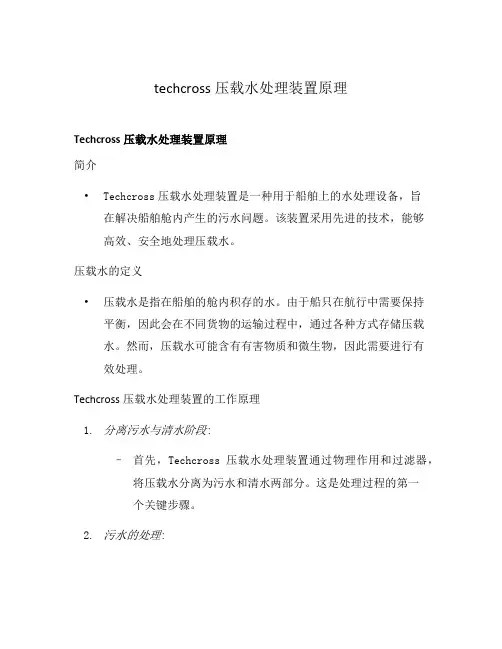
techcross压载水处理装置原理Techcross压载水处理装置原理简介•Techcross压载水处理装置是一种用于船舶上的水处理设备,旨在解决船舶舱内产生的污水问题。
该装置采用先进的技术,能够高效、安全地处理压载水。
压载水的定义•压载水是指在船舶的舱内积存的水。
由于船只在航行中需要保持平衡,因此会在不同货物的运输过程中,通过各种方式存储压载水。
然而,压载水可能含有有害物质和微生物,因此需要进行有效处理。
Techcross压载水处理装置的工作原理1.分离污水与清水阶段:–首先,Techcross压载水处理装置通过物理作用和过滤器,将压载水分离为污水和清水两部分。
这是处理过程的第一个关键步骤。
2.污水的处理:–分离出的污水进一步通过化学和生物处理,以去除其中的有害物质和微生物。
这一过程中,Techcross压载水处理装置采用先进的滤材和反应器,确保污水经过系统处理后符合环境标准。
3.清水的处理:–清水经过预处理后,进一步经过反渗透膜过滤器进行过滤,去除其中的杂质和微生物。
最终得到符合安全饮用水标准的清水。
Techcross压载水处理装置的优势•高效处理能力:Techcross压载水处理装置能够高效地处理大量的压载水,确保船舶舱内的水资源得到合理利用。
•安全可靠:装置采用多级处理,能够彻底去除污水中的有害物质和微生物,保证船员和环境的安全。
•环保节能:该装置采用先进的技术和材料,减少了能耗和废物的产生,符合环保要求。
•智能控制:Techcross压载水处理装置配备智能控制系统,可根据实际情况进行调节,提高工作效率和处理质量。
结论•Techcross压载水处理装置凭借其先进的工作原理和优越的性能,成为船舶上处理压载水的重要设备。
通过分离、处理和过滤,该装置能够将压载水处理成符合环保标准的污水和清水,为船舶提供安全、可靠的水资源。
压载水处理装置的工作原理详解Techcross压载水处理装置采用多阶段的处理过程,确保压载水得到深度处理,使其达到环保标准和安全饮用水标准。

船舶压载水处理技术及应用研究文章主要针对压载水处理技术的相关应用和发展趋势进行研究,并分析了几种主要压载水处理技术的应用,以及压载水处理技术对船舶相关设施的影响,探讨该技术系统的设计与设备选用等相关问题。
标签:船舶;压载水处理技术;应用研究1 压载水处理技术基本概述在国际海事组织进行压载水控制开始时期,压载水处理技术普遍发展不成熟,达不到排放控制标准,因此,一些国家为了自身的海洋利益,选择在远离本土海域置换压载水,以减少对本国海域的生态影响。
比如以色列、新西兰以及澳大利亚都规定,如果船舶要停靠在该国,必须在较远的海域先释放压载水,以色列则更加严格,要求船舶的压载水排放和更换要在红海之外。
从根本上来看,这种远洋置换压载水的方法,并不能根本上解决污染问题,本质上知识污染的转移。
2004年国际海事组织出台的《公约》对船舶压载水制定了管理标准,该标准以船舶的建造年份及压载水量的实际情况为依据,对压载水控制有不同的标准(如表1所示)。
有些国家为了进一步保护自身的生态环境,在各项标准及指标上甚至要比《公约》当中的标准更加严格。
2 压载水处理技术应用分析关于在压载水处理技术的研究,在国际上的研究方向较多且比较全面,主要包含了物理方面的处理技术和化学方面的处理技术,如下:2.1 物理处理法所谓压载水处理的物理方法,主要通过稀释、加热、离心、过滤、光照等物理手段,来消除海水当中的有害物质,达到压载水的净化处理。
比如物理处理法当中的过滤处理,就是将海水通过一定的过滤装置,排除污染物。
过滤装置能够自动排除外来生物,利用网目筛选生物种群。
当前用于船舶压载水处理的过滤装置有纳滤膜件和超滤膜件。
这些装置在船舶上的安装比较简便,操作起来也比较简单,而且采购和安装这些过滤装置的成本不用很高,性价比相对较高。
过滤法的不足之处就是难以对于一些体积十分微小的污染进行过滤处理。
因此,过滤法在实际应用中,通常与其他处理措施配套使用,达到效果最大化。

船舶压载水处理装置(BWMS)技术条件(企业标准)(第一版)20XX年X月XX日发布20XX年X月XX日实施拟制:批准:日期:日期:1.内容及适用范围本标准规定了船舶压载水处理系统的设计,制造,检验,性能测试方法及包装,运输,贮存等要求。
本标准适用于船舶压载水处理系统的设计、制造和检验。
压载水管理系统,是基于国际海事组织(IMO)关于《国际船舶压载水及其沉积物控制和管理公约》D-2规定,设计并建造的船舶压载水处理系统,目的在于有效控制压载水中的海洋生物,病毒和其它微生物的转移,防止外来物种的迁徙。
本系统适用于远洋船舶的压载水处理。
本系统也适用于中水回用,工业冷却水系统等的末端处理。
本产品特点是采用纯物理处理工艺,不添加或产生任何化学物质,对船舶无任何腐蚀影响。
设备布置紧凑,占地小,系统全自动控制,操作简单,维护方便等。
2. 引用标准下列标准所包含的条文,通过在本标准中引用而构成本标准的条文。
如其中某个标准被修订,使用本标准应参照相应的最新版执行。
IMO,《2004年国际船舶压载水及其沉积物控制和管理公约》IMO,《船舶压载水管理系统认可导则》(G8)IMO,《船舶压载水管理系统取样导则》(G2)Resolution MEPC, 173(58)中国船级社,《船舶压载水管理计划编制指南》(2006)中国船级社,《电气电子产品型式认可试验指南》(2006)3. 产品组成及型号3.1 产品组成船舶压载水处理系统由全自动自清洗过滤器、紫外杀菌装置和控制系统三个主要部分组成。
3.2 产品命名及型号编制方法防爆型代码额定处理能力(m3/hr)压载水处理装置代码公司代码3.3 产品规格3.3.1 BWMS 设备规格系列3.3.2 自清洗过滤器规格系列3.3.3 UV(紫外)消毒装置规格系列4. 产品技术要求及参数4.2 技术要求:采用机械过滤加中压紫外消毒的工艺对压载水进行有效处理;对于处理后的压载水,按照公约进行压载水管理的排放,达到公约D-2条规定,其中的生物浓度:1).最小尺寸大于或等于50 μm的存活生物少于10个/m3;2).最小尺寸小于50 μm但大于等于10 μm的存活生物少于10个/mL。

阐述船舶压载水处理技术及处理系统随着船舶压载水在港口领域频繁的排出和压入产生了大量细菌和浮游生物,为各种病原体提供了转移和船舶通道,为外来物种的入侵提供了渠道,严重影响了海洋环境和公众安全。
为了降低、消除船舶压载水排放对公众安全和海洋环境造成的影响,国际海事组织对船舶压载水的控制和排放提出了要求,为了达到公约中的要求,迫切需要进行压载水处理系统的选型和安装。
1 较为常见的压载处理技术1.1 利用物理化学方法进行处理1.1.1 紫外线处理法:通过放在石英套管中的汞灯对大小不同的微生物的照射,从而达到处理微生物的目的。
1.1.2 脱氧处理法:通过向压在水中加注惰性气体,使水中的氧气排出,而水中的微生物由于缺氧会窒息死亡,以此达到处理的效果。
1.1.3 超声波处理法:由于超声波作用于压载水时会产生一定的热量及压力波偏向,从而使微生物的表面细胞壁被破坏,继而起到杀灭生物体的作用。
1.1.4 加热处理法:通过对柴油机的冷却水的利用,使压载水的温度达到38℃~50℃,且需要保持一段时间,以此消灭压载水中的微生物。
1.1.5 氧化处理法:通过臭氧或者过氧化氢在相关环境的释放使生物的酶出现变性而死亡。
1.1.6 氯化处理法:通过电解压载水等方法产生出氯离子,从而达到杀灭微生物的作用。
1.2 具体的机械处理法通常对于压载水中相对较大的生物及杂质会用机械处理法进行处理。
具体方法包括过滤及旋分等技术,一般会将滤出的物质返回海洋,也可以将其存储在专门的单仓中定点进行处理。
2 我国对压载水处理系统的研究现状现阶段,我国针对压载水的处理设备的研发已经有较多的企业进行了参与,而且投入的资金量也非常可观。
按照有关公约规定,相关船舶压载水处理系统应由相关国家主管机关进行签发认可,而船舶若行至美国水域则还需要更高形式的认可方式。
截至去年,我国已经有一部分船舶得到了相关国际公约的认可。
站在相关处理技术的角度进行分析:较多厂家在技术水平上难分高低,但仔细进行了解发现,每个系统都存在程度不同的缺陷,因此为了提高相关系统在国际上的认可度及竞争力,就必须对相关产品进行升级换代,同时做好有关的售后服务工作,只有这样才可能提升自己、壮大自己。
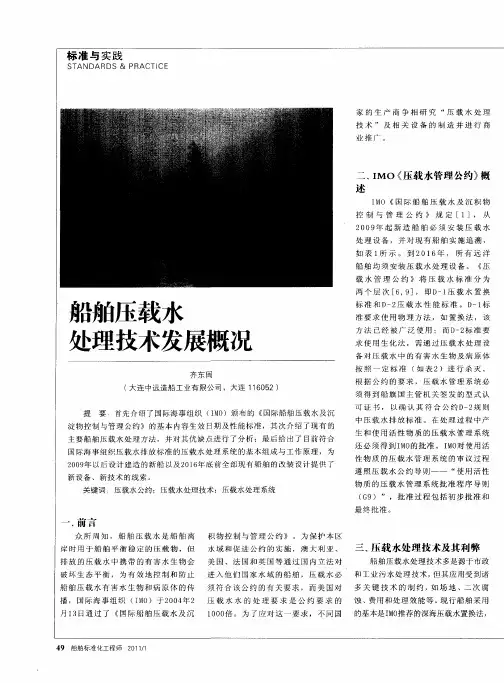

第35卷大连海事大学学报V ol.35 2009年6月Journal of Dalian Maritime University Jun. 2009文章编号:1006 7736(2009)S1 0058 03压载水处理技术评估毕占新1,李永涛2(1.北海海事局指挥中心,广西北海 536000;2.天津海事局新港海事处,天津 300456)摘要:根据即将生效的压载水公约对压载水处理的要求,对世界范围内流行的压载水处理技术进行分析、比较,指出两种处理技术中过滤和消毒的具体方法的优缺点,认为单一处理方法不能满足公约要求.关键词:处理技术;压载水公约;过滤;消毒中图分类号:X52 文献标志码:AEvaluation of the treatment technologiesof ballast waterBI Zhan x in1,LI Yong tao2(1.Instruction Center,Beihai M aritimeSafety Administration,Beihai536000,Ch i na;2.X inga ng M arine De p artment,Tianjin M aritimeSafety Administrati on,Tianjing300456,China)Abstract:T his article has analyzed and compar ed the worldwide prevalence ballast water treatment technolog ies which required by the forthcoming entry into force the Convent ion of Ships Ballast Water.T he paper pointed out the specific advantag es and disadvantages of two type of treatment technolog ies sep aration and disinfection treatment respectively.T he conclusions drawn to a single approach can not achieve t he r equirements of t he Conventio n of Ships Ballast Water.Key words:treatment technolog y;Convention of Ships Ballast Water;separ ation;disinfectio n0 IntroductionShipping is the backbone of the global economy and transport more than80%of world trade.On car go vessels w ater ballast is added to the ballast tanks w hen unloaded to increase propeller immersion,to improve maneuvering characteristic,and to control trim and draft[1].Container ships,large tankers,and bulk cargo carriers use a large amount of ballast w a ter,w hich is often pumped in the coastal waters in one port after ships unload cargo,and discharged at the loading port,wherever more cargo is loaded.It is estimated that one billion tones of ballast w ater is transported around the w orld each year.Invasions of organisms through ships ballasting w ater considered to be one of the important aspects threatening the nat urally biodiversity and the consequences of such inva sions are being realized specially in the recent years. IMO has been working through its member states to think the problem of ballast w ater and introduced the International Convention for the Control and M anage ment of Ships Ballast Water and Sediments in 2004[2].T he convention includes a ballast w ater per form ance standard to regulate discharges of ballast w a ter and reduce the risk of introducing non indigenous species from ships ballast w ater.This paper focus on these matters and the m ain object w ill be to evaluate methods to treat ships ballast w ater.1 T wo general types of ballast watertreatmentThe requirement for ballast w ater treatment has found in the BWM Convention.Number of technolo g ies has been developed by different vendors.T here are tw o general types of process technology used in ballast w ater treatment:solid liquid separation and disinfection.Solid liquid separation is just the separa tion of solid material,including the larger suspended micro organisms,from the ballast w ater,either by收稿日期:2009 04 28.作者简介:毕占新(1972-),男,辽宁义县人,工程师,E mail:bizhanx in@.sedimentation,or by surface filtration.The chem ical enhancem ent such as:coagulation and flocculation are belonging to this category.Disinfection removes and or inactivates micro org anisms using one or combines the methods:2 Separation processesT he chem ical or physicochem ical unit processes used for disinfectant pretreated by physical solid liquid separation method,by either filtration or hydrocy clone technology.T he filtration processes used in ballast water treatm ent systems are generally of the autom atic backw ashing type using either discs or fix ed screens. Removal of larger organisms such as plankton by fil tration requires a filter of equivalent mesh size be tw een10and50 m.Such filters effective operation relates mainly to the flow capacity attained at a given operating pressure.M aintaining the flow norm ally requires that the filter is regularly cleaned,and it is the balance between flow,operating pressure and cleaning frequency that determ ines the efficacy of the filtration process.In principle,surface filtrations are not viable for ballast w ater treatment due to the rela tively low permeability of the membrane material. Hy drocyclone technology is also used as an alternative to filtration,providing enhanced sedimentation by in jecting the w ater at high velocity to impart a rotation al motion w hich creates a centrifugal force w hich in creases the velocity of the particle relative to the w a ter.The effectiveness of the separation depends upon the difference in density of the particle and the sur rounding water,the particle size,the speed of rota tion and residence time.Since both hydrocyclones and filters are more effective for larger particles,pre treatm ent with coag ulants to ag gregate(or!floccu late )the particles may be used upstream of these processes to increase their efficacy.How ever,because flocculation is time dependent,the required residence time for the process to be effective demands a relative ly large tank[3].3 DisinfectionCurrently there are tw o m ain generic types of process in this field:Chemical disinfection and Physi cal disinfection w hich w ere described below.3.1 Chemical disinfectionNumerous chemicals or chemical processes have been employed in the ballast water treatment systems described below:The efficacy of these processes depends on the conditions of the w ater such as pH,temperature and, most significantly,the ty pe of organism.Chlorine w hich relatively inex pensive is virtually ineffective against cysts.Chlorine leads to undesirable chlorinated byproducts,particularly chlorinated hydrocarbons and trihalomethanes.Ozone yields far few er harmful byproducts,the most prominent being bromate,but requires relatively complex equipment to both produce and dissolve it into the w ater.Chlorine diox ide is norm ally produced in situ,although this pr esents a hazard since the reagents used are themselves chemically hazardous.Peracetic acid and hydrogen peroxide(provided as a blend of the tw o chemicals in the form of the proprietary product Peraclean)are in finitely soluble in w ater,produce few harmful byprod ucts and are relatively stable as Peraclean.How ever this reagent is relatively ex pensive,is dosed at quite high levels and requires considerable storage facilities[3].For all these chem icals pre treatment of the w a ter is desirable to reduce the use of the chemical,but the chemical can also react w ith organic and other ma terials in the ballast w ater.To avoid secondary tox ici ty risk on the environment by the above chem ical treatment of ballast water is to be considered.3.2 Physical disinfectionThere is several physical disinfection methods de veloped.Some has been adopted as municipal water treatment application.Ultrav iolet irradiation(UV) s process employs amalg am lamps surrounded by a quartz sleeve w hich can provide UV light at different w aveleng ths and in tensities,depending on the particular application.It is w ell known to be effective against a w ide range of microorganisms,including viruses and cysts,but re lies on g ood UV transmission through the w ater and hence needs clear water and unfouled clean quartz59毕占新,等:压载水处理技术评估sleeves to be effective.The rem aining physical disin fection processes do not inherently require use of pre treatm ent.How ever,the efficacy of both processes is subject to limitations.Deoxygenation takes a number of days to come into effect due to the leng th of time it takes the organisms to be asphyxiated.How ever, most voyages w ill exceed this time period so this should not be a sig nificant constraint.Cavitation or ultrasonic treatment processes both act at the surface of the m icro organism and disrupt the cell w all throug h the collapse of m icrobubbles.T hese processes are currently not as w ell understood as the other more established disinfection technolog ies[3].Lioyd s Reg ister,Ballast Water Treatment Technolog y Sum mary of the above mentioned ballast water treatment techniques about their advantages and dis advantages are find in table1w hich at the end of this paper.4 ConclusionThe result can be established from the above ele vation of treatm ents of ballast w ater,there is no one signals treatment technology can meet the requirement of the BWM convention[4].So the only choice of suc cessful treatm ent must integrate tw o or more technol ogy to achieve the goal satisfies the convention.Table1 Comparison of treatmentsAdvantages DisadvantagesSolid liqui d separationFiltrati onH ydrocyclon eCoagulationand FlocculationCapable ofremovingmaterialsabove aspecific sizeRemoval of larger organi sms such as planktonM ore effective for largerparti clesThe flow capaci ty attained at a given operating pressure;Relatively low permeability of the membrane material;Operating pressure and cleaning frequency that determ i n es the efficacy.The effectiveness of the separation depends upon the difference in density ofthe particle and the surrounding w ater,the particle size,the speed of rotationand residence ti m e.Required residence time for the processto be effective demands a relatively largetankDisinfectionChemicaldisinfectionPhysicaldisinfectionChlorineOzoneChlorinedioxidePeraceticacid andhydrogenperox i deultravioletirradiation(UV)DeoxygenationCavi tation orultrasonicNosecon darytoxicity riskInexpensiveFar few er harmfulbyproductsIneffective against cysts;Leads to undesirable chlori nated byproducts.Effective against a widerange of microorganis ms,includi ng viruses and cystsDo not require use ofpre treatmentS econdary tox i cityrisk;Efficacy of th eseprocesses depends onthe conditions of thew ater s uch as pH,temperature and,most significantl y,the type oforganism.Ineffective against cysts;Leads to undesirable chlorinated byproducts.Requires relatively complex equi pmentChemicall y hazardousRelatively stable as Peraclean.Relativelyexpensive;Dosed at quite high levels;Requires considerable storage faci litiesNeeds clear water and unfouled clean quartz sleevesTakes a number of days to come into effect due to the length of time it takes theorganisms to be asphyxiated.Not as w ell understood as the otherReferences:[1]T he meaning of ballast w ater[EB OL].[2008 10 13].http: en.w w iki Sailing-ballast.[2]IM O.International Convention for the Co ntrol and M anagement of Ships Ballast Water and Sediments[M].2004.[3]Lio yd s R eg ister.Ballast w at er treatment technolog y curr ent status[J].2008.[4]T he signal treatment of ballast water is impossibilit y[EBOL][2008 10 15].http: www.lunw pr od uct.free.3819311.1 .60大连海事大学学报 第35卷。
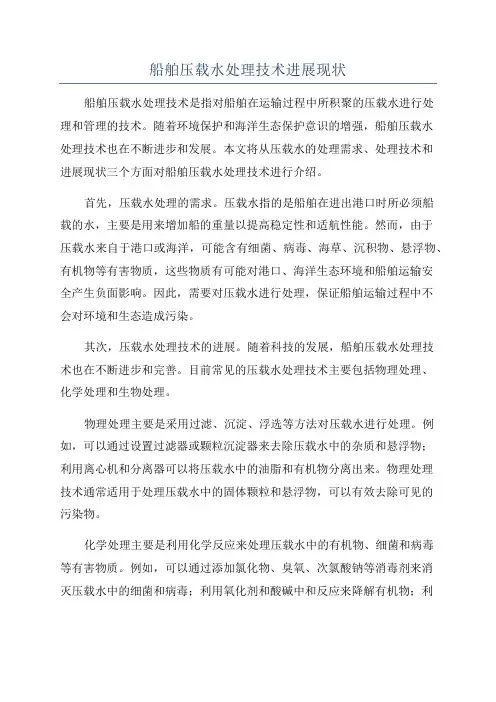
船舶压载水处理技术进展现状船舶压载水处理技术是指对船舶在运输过程中所积聚的压载水进行处理和管理的技术。
随着环境保护和海洋生态保护意识的增强,船舶压载水处理技术也在不断进步和发展。
本文将从压载水的处理需求、处理技术和进展现状三个方面对船舶压载水处理技术进行介绍。
首先,压载水处理的需求。
压载水指的是船舶在进出港口时所必须船载的水,主要是用来增加船的重量以提高稳定性和适航性能。
然而,由于压载水来自于港口或海洋,可能含有细菌、病毒、海草、沉积物、悬浮物、有机物等有害物质,这些物质有可能对港口、海洋生态环境和船舶运输安全产生负面影响。
因此,需要对压载水进行处理,保证船舶运输过程中不会对环境和生态造成污染。
其次,压载水处理技术的进展。
随着科技的发展,船舶压载水处理技术也在不断进步和完善。
目前常见的压载水处理技术主要包括物理处理、化学处理和生物处理。
物理处理主要是采用过滤、沉淀、浮选等方法对压载水进行处理。
例如,可以通过设置过滤器或颗粒沉淀器来去除压载水中的杂质和悬浮物;利用离心机和分离器可以将压载水中的油脂和有机物分离出来。
物理处理技术通常适用于处理压载水中的固体颗粒和悬浮物,可以有效去除可见的污染物。
化学处理主要是利用化学反应来处理压载水中的有机物、细菌和病毒等有害物质。
例如,可以通过添加氯化物、臭氧、次氯酸钠等消毒剂来消灭压载水中的细菌和病毒;利用氧化剂和酸碱中和反应来降解有机物;利用絮凝剂来加速颗粒物的沉淀。
化学处理技术可以有效去除压载水中的微生物和有机污染物,提高水质的卫生安全性。
生物处理主要是通过微生物的生物降解作用来处理压载水中的有机物。
例如,可以利用厌氧生物反应器或生物滤池来降解压载水中的有机污染物;利用微生物活性池来促进压载水中有害物质的降解。
生物处理技术具有能耗低、处理效果好、环保性强等优点,逐渐成为船舶压载水处理的主要方法之一最后,船舶压载水处理技术的进展现状。
随着相关标准和法规的不断制定和完善,船舶压载水处理技术得到了广泛应用和推广。
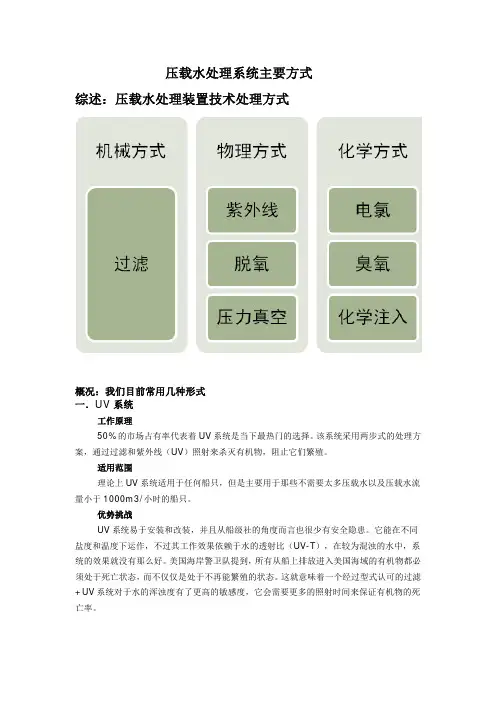
压载水处理系统主要方式综述:压载水处理装置技术处理方式概况:我们目前常用几种形式一.UV系统工作原理50%的市场占有率代表着UV系统是当下最热门的选择。
该系统采用两步式的处理方案,通过过滤和紫外线(UV)照射来杀灭有机物,阻止它们繁殖。
适用范围理论上UV系统适用于任何船只,但是主要用于那些不需要太多压载水以及压载水流量小于1000m3/小时的船只。
优势挑战UV系统易于安装和改装,并且从船级社的角度而言也很少有安全隐患。
它能在不同盐度和温度下运作,不过其工作效果依赖于水的透射比(UV-T),在较为混浊的水中,系统的效果就没有那么好。
美国海岸警卫队提到,所有从船上排放进入美国海域的有机物都必须处于死亡状态,而不仅仅是处于不再能繁殖的状态。
这就意味着一个经过型式认可的过滤+UV系统对于水的浑浊度有了更高的敏感度,它会需要更多的照射时间来保证有机物的死亡率。
主要厂家代表1.中远海盾2.无锡蓝天3.PANASIA, Korea4. ALFA LAVAL二.电解系统工作原理电解处理系统拥有约35%的市场占有率,这使它成为排名了第二的处理系统。
很多这类的系统都会使用过滤来进行预处理。
通过给海水的一支流通电,该系统让盐与水分子发生化学反应生成消毒剂——次氯酸盐,然后再将次氯酸盐重新注入压载水以杀死有机物。
适用范围电解系统更适用于拥有较大压载水容量的大型船只,它能承受最高8000m3每小时的流量。
优势挑战除了能适应较大的压载水容量外,以电解为基础的处理系统也非常有效。
它对于水的处理,只需要在打压载时进行(在排压载时可能需要进行适当中和)。
这就意味着该系统能在船上也进行杀菌处理,甚至在一些无法进行压载水处理的港口,有些电解系统还能在航行途中提供舱内循环处理。
不过这个系统也有一些缺点,其中之一就是电解反应时会产生少量氢气,这一因素需要被纳入安全考虑范围内。
除此之外,电解系统对低盐低温的环境也非常敏感,因而在需要的时候我们应适当加入一些盐或者加装一套加温系统。

HEADWAY 压载水处理系统原理介绍一、EUT处理原理和AOP 技术:EUT的处理原理是使用电子激发特殊的半导体材料,利用水分子形成高活性的羟基自由基(·OH),通过破坏微生物的细胞膜来杀死水中的微生物、细菌及病毒,并能够减少水中其他有机物。
我们称该技术叫AOP(Advanced Oxidation Process)技术,它是一种高效节能、环保的水处理技术,不产生任何副产品和化合物。
二、EUT处理过程:EUT单元可以产生大量羟基自由基(·OH)。
羟基自由基(·OH)是一种重要的活性氧,从分子式上看是由氢氧根(OH-)失去一个电子形成;羟基自由基具有极强的氧化能力,是自然界中仅次于氟的氧化剂。
它存在的时间非常短,可以瞬间与微生物或其他有机污染物发生反应,从而完成灭菌消毒过程,由于存在和反映时间只有几纳秒因此不会对管道和船体造成腐蚀。
三、AOP 技术的优势:1、产生羟基自由基(·OH)通过杀死细胞膜来灭菌所需要的能量,要远低于使用其他方式灭菌所需的能量。
这就是Headway压载水处理系统比其他处理系统更节能的主要原因。
2、产生的羟基自由基可以完全杀死细胞,而传统水处理装置处理过的微生物细胞,可能会复活。
3、AOP技术的杀菌效果不受水的色度、浊度、流速、温度、PH值、盐度等因素的影响。
四、电催化产生自由基的原理:自由基是一种携带一个或多个不成对的电子独立存在的原子或分子的物质。
对化学性能最重要的是原子或分子外层的价电子,如果外层价电子没有配对成功,就形成了自由基。
没配对的电子独占原子或分子的一个电子轨道。
当自由基从另外一个物质获得一个额外电子时,一个新离子就会产生。
如果原子间的共价电子被其中一个原子夺取,也就打破了原来的共价平衡,同时形成了两个新的离子。
五、化学反应方程式:EUT单元不需要添加任何化学物质,化学反应过程依赖于H2O和半导体材料。
根据水中污染物的不同,会有不同的化学反应。
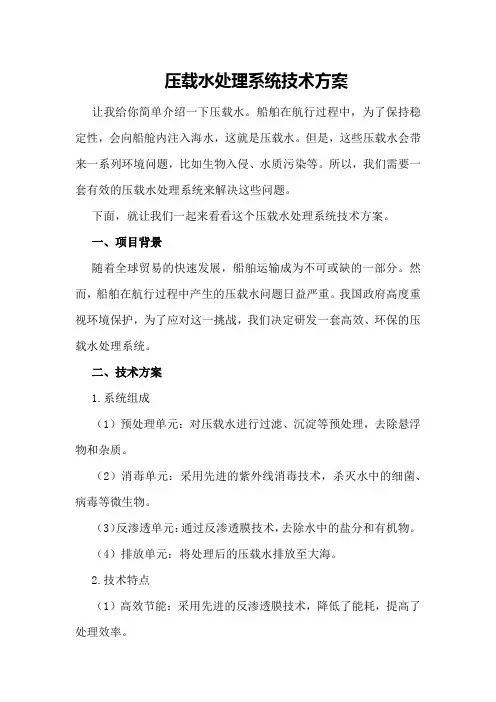
压载水处理系统技术方案让我给你简单介绍一下压载水。
船舶在航行过程中,为了保持稳定性,会向船舱内注入海水,这就是压载水。
但是,这些压载水会带来一系列环境问题,比如生物入侵、水质污染等。
所以,我们需要一套有效的压载水处理系统来解决这些问题。
下面,就让我们一起来看看这个压载水处理系统技术方案。
一、项目背景随着全球贸易的快速发展,船舶运输成为不可或缺的一部分。
然而,船舶在航行过程中产生的压载水问题日益严重。
我国政府高度重视环境保护,为了应对这一挑战,我们决定研发一套高效、环保的压载水处理系统。
二、技术方案1.系统组成(1)预处理单元:对压载水进行过滤、沉淀等预处理,去除悬浮物和杂质。
(2)消毒单元:采用先进的紫外线消毒技术,杀灭水中的细菌、病毒等微生物。
(3)反渗透单元:通过反渗透膜技术,去除水中的盐分和有机物。
(4)排放单元:将处理后的压载水排放至大海。
2.技术特点(1)高效节能:采用先进的反渗透膜技术,降低了能耗,提高了处理效率。
(2)环保安全:紫外线消毒技术避免了化学消毒剂的二次污染。
(3)智能控制:系统具备自动监测、报警、切换等功能,确保运行稳定。
(4)易于维护:模块化设计,方便维修和更换部件。
三、实施方案1.设备选型(1)预处理设备:包括过滤器、沉淀池等。
(2)消毒设备:紫外线消毒装置。
(3)反渗透设备:反渗透膜组件。
2.设备安装(1)预处理设备安装:将预处理设备安装在船舶甲板上,连接管道和电源。
(2)消毒设备安装:将紫外线消毒装置安装在预处理设备之后,连接管道和电源。
(3)反渗透设备安装:将反渗透膜组件安装在消毒设备之后,连接管道和电源。
3.系统调试设备安装完成后,进行系统调试,确保各设备正常运行,处理效果达到预期。
四、项目优势1.环保:有效减少船舶压载水对海洋环境的污染。
2.经济:降低船舶运营成本,提高经济效益。
3.安全:保障船舶航行安全,避免生物入侵等风险。
4.社会效益:提升我国环保形象,为全球环保事业作出贡献。
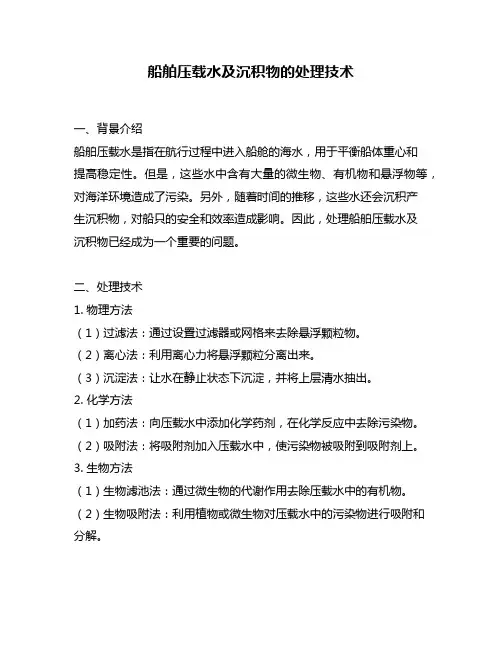
船舶压载水及沉积物的处理技术一、背景介绍船舶压载水是指在航行过程中进入船舱的海水,用于平衡船体重心和提高稳定性。
但是,这些水中含有大量的微生物、有机物和悬浮物等,对海洋环境造成了污染。
另外,随着时间的推移,这些水还会沉积产生沉积物,对船只的安全和效率造成影响。
因此,处理船舶压载水及沉积物已经成为一个重要的问题。
二、处理技术1. 物理方法(1)过滤法:通过设置过滤器或网格来去除悬浮颗粒物。
(2)离心法:利用离心力将悬浮颗粒分离出来。
(3)沉淀法:让水在静止状态下沉淀,并将上层清水抽出。
2. 化学方法(1)加药法:向压载水中添加化学药剂,在化学反应中去除污染物。
(2)吸附法:将吸附剂加入压载水中,使污染物被吸附到吸附剂上。
3. 生物方法(1)生物滤池法:通过微生物的代谢作用去除压载水中的有机物。
(2)生物吸附法:利用植物或微生物对压载水中的污染物进行吸附和分解。
三、常见处理设备1. 压力过滤器:通过高压将水通过过滤介质,去除悬浮颗粒和微生物等。
2. 沉淀池:让水在静止状态下沉淀,再将上层清水抽出。
3. 生物滤池:利用微生物的代谢作用去除有机物。
4. 吸附剂反应器:加入吸附剂并与压载水进行反应,将污染物吸附到吸附剂上。
四、处理流程1. 进水口:船舶压载水进入处理系统。
2. 过滤处理:使用过滤器或网格去除悬浮颗粒和微生物等。
3. 化学处理:向压载水中添加化学药剂,在化学反应中去除污染物。
4. 生物处理:利用微生物的代谢作用去除有机物。
5. 沉淀处理:让水在静止状态下沉淀,并将上层清水抽出。
6. 出水口:经过多重处理后,船舶压载水达到国家排放标准,可以直接排放到海洋中。
五、处理效果经过处理后,船舶压载水中的微生物、有机物和悬浮物等均被去除或分解,达到了国家排放标准。
同时,沉积物也得到了有效的处理,不会对船只的安全和效率造成影响。
六、总结船舶压载水及沉积物的处理技术是一个复杂而且重要的问题。
通过物理、化学和生物等多种方法进行处理,可以有效地去除污染物,并达到国家排放标准。
1国外主要的压载水处理系统介绍1.1NEI公司的文氏管脱氧方式压载水处理系统(Venturi Oxygen Stripping——VOS)NEI公司从2002年开始致力于研制VOS系统来解决水栖有害生物问题,同时保护压载舱不被腐蚀。
该系统使用氮气在船舶压载舱内制造一个低氧的环境,该环境限制了含氧量,避免了氧化铁或锈的形成;同时,该低氧环境极大降低了随压载水带来的水栖生物的生存率。
该项技术已在船舶实验中得到证明,完全符合IMO的压载水排放标准。
图1为VOS系统流程图。
VOS系统与船舶现有的压载系统相结合,当吸入的压载水流经安装在压载管路上的文氏管喷射器时,将会发生空化现象;同时在其中喷入由制氮装置产生的氮气,使其达到过饱和。
经过这一过程,压载水中的含氧量将在l0s内减少95%。
当压载水排出压载舱时,VOS系统将通过甲板管路向空舱中注入氮气,以使压载舱中保持低氧的环境。
此脱氧过程可参见图2。
该系统通过了美国船级社的技术审查,获得了利比里亚船级社的形式认可,具备装船条件。
1.2OceanSaver公司的OceanSaver系统OceanSaver的工作原理,是分两个阶段使压载水中氮气过饱和。
压载水经由船舶的海水吸人箱抽吸到船上,先经过滤清、再进入C3-T空化室,承受极高压力脉冲的作用;紧接着空化作用之后,在船上利用膜板型氮气发生器生产的氮,在一个两级处理过程中喷入水流。
有一部分水从主水流中分出,利用混合装置与氮气混合或实现过饱和。
然后这部分水流立刻被重新喷射到主水流中,在此与来自C2-E系统的活化水合流。
一小部分压载水(小于规定的系统流量的0.5%)在过滤以后被送入C2-E系统,在此受到电渗析处理,然后与氮气一同被重新喷射入水流中,对压载水进行消毒。
C2-E系统的组成包括给水和喷射管路、恒定电流电源装置及电渗析单元组件。
水过滤之后,经过空化和过饱和的处理后,成含氧量低的水,此时即进入压载舱。
水舱配备有压力/真空控制系统,用以防止氮气从水舱内泄漏出来,并防止水舱受空气污染,这样便抑制了水生物再生的可能性,水舱壁表面的氧化(由此引起的腐蚀和涂层的老化)也明显减少。
压载水处理装置操作流程Operating a ballast water treatment system is an essential task for ship operators and crew members. 操作压载水处理系统是船舶运营人员和机组成员的基本任务。
By following a strict operational procedure, potential environmental and economic risks can be minimized. 通过遵循严格的操作程序,可最大程度地减少潜在的环境和经济风险。
The process involves several steps to ensure that the system effectively treats the ballast water before it is discharged into a new location. 该过程涉及多个步骤,以确保系统在将压载水排放到新位置之前有效地进行处理。
First and foremost, it is crucial for crew members to be trained on the proper operation of the ballast water treatment system. 首先,机组成员在正确操作压载水处理系统上接受培训至关重要。
This training should include both theoretical knowledge and practical skills, allowing the crew to understand the principles behind the system and how to troubleshoot any issues that may arise. 这种培训应包括理论知识和实际操作技能,使机组成员能够理解系统背后的原理以及如何解决可能出现的任何问题。
关于压载水处理系统,听听USCG最新解说关于压载水处理系统,听听USCG的现场报道!5月29日,DNV-GL邀请AMSA,USCG和利比里亚船旗国的负责人在新加坡为船东们举办了一个关于PSC检查的论坛。
期间来自美国海岸警卫队(USCG)的LT.Matthew Fredrickson关于美国压载水管理做了最新解释。
关于《压载水管理公约》,生效已接近两年,业界已经从最初的担忧甚至是恐慌到现在非常理智地接受。
美国压载水法规(33 Code FederalRegulations Part 151)于2012年6月生效,其中的要求与国际海事组织的《压载水管理(BWM)公约》有所不同。
1、为了更好地理解,我们再回顾一下什么是D-1,D-2,G8,G9。
D-1和D-2是《BWM公约》引入的两套标准:D-1标准为压载水置换标准,公约生效前及生效以后船舶安装压载水管理系统BWMS以前,应采用的压载水处理标准;本条标准的船舶压载水体积交换效率,应至少为95%,对于使用泵透(Pumping through)方法(包括溢流法Flow-through method和稀释法Dilution method)更换压载水的船舶,应三倍于每一压载水舱体积,对于少于该体积三倍的泵透法,如果船舶证明已达到了95%的体积交换,则也可被接受。
开始强制实施D-2标准之前,将有一段只要求符合D-1标准的过渡期。
船级社签发的压载水管理证书BWMC中,要求注明压载水处理方式:D-2标准为压载水处理标准,压载水公约生效以后,并在安装压载水管理系统以后,应满足的标准;本条标准的船舶压载水排放所含有的可存活生物,其尺寸在大约或等于50微米时,每立方米要少于10个,其尺寸小于50微米时,但大于或等于10微米时,每毫升要小于10个的可存活生物;并且,作为一种人体健康标准,①每100毫升要少于1个菌落形成单位(cfu) 的有毒零乱弧菌(O1和O139),或每一克小于1个cfu浮游动物样品(湿重);②每100毫升要少于250个cfu大肠杆菌;③每100毫升要少于100个cfu肠球菌。
Erma first BWTS,操作说明压载水处理系统简介第一阶段:通过全自动自清洁40微米过滤器过滤第二阶段:通过产生仅4-6ppm(mg/l)的游离氯进行全流式电解消毒是什么让ERMAFIRSTBWTSFIT和出色的选择ERMAFIRSTBWTSFIT采用业内TopHouse制造的真正*组件,因此整个系统压降小于0.5bar,平均功耗为1.8KW/100m3/hr处理水,经认证在海水,微咸水和淡水(0.9PSU)条件下运行,组件占地面积小,价格有竞争力,仅在压载过程中使用。
此外,与其他电解系统相比,USCG型号认证的操作限制少。
附USCGTA附件。
ERMAFIRSTBWTSFIT是一个非常可靠的选择,每个方面都有所不同。
•该系统仅在压载期间使用,并且在去压载期间完全旁路。
•可在各种水盐度(新鲜,咸淡,海水)和温度(>-2°C,请参阅我们的USCG)中使用•不需要保持时间,船舶操作在端口呼叫和背靠背操作之间保持不受限制•系统的性能效果不受水浊度的影响•系统采用TopHouses严格制造的组件•FILTREX&FILTERSAFE迄今为止提供的优质过滤器选择(均符合USCG类型)•除系统的标准保修外,电解槽还有5000小时的保修期电解槽没有活动部件,没有备件,因此业主在运行期间可以节省大量成本•系统的模块化设计使得所有类型的容器都可以安装•IMO和USCG认证之间不需要进行任何设计更改/升级•氢气产量可忽略不计,不需要任何额外的处理规定(不需要鼓风机,旋风分离器,传感器,具有高度防腐性能的管道等)•维护成本极低(明显低于其他技术)。